The curious case of Mexico’s 1888 50 Centavos
by Brian R. Stickney
T.V. ButtreyButtrey, T.V., A Guidebook to Mexican Coins, 1822 to Date, Western Publishing Company, Racine, 1969, Larry HanksHanks, Larry W., The Comprehensive Catalog and Encyclopedia of Republic Mexican Coins, El Paso, 1976, and other early cataloguers of Mexican coins show no listings for Mexican 50-centavos coins dated 1888 for any of the several mints active during that period. Pradeau, writing his classic multi-volume series in the late 1950s and early 60sPradeau, A. F., Historia Numismatica de México; Vol. II and III, 1960 and 1961, provides mintage data on a fiscal year basis for gold, silver and copper coinage during the Republic period. Pradeau’s data shows that no such coin was struck in any of the mints. He does list some 2,000 fifty-cent pieces reported for the 87-88 fiscal year in Zacatecas which would cover the period of 1 July 1887 thru 30 June 1888. But, to date, no 1888 fifty-centavos from that mint have been reported. Likely, all those coins were struck in the first half of the fiscal year, to wit, in calendar year 1887. In fact, both early and contemporary catalogues suggest that coining of the 50-centavos was largely suspended after 1887 with only Culiacán and Hermosillo striking the denomination for a couple of years in the 1890s.
But rumors persisted that 1888 specimens existed and, in 1981, Krause PublicationsKrause Publications, Standard Catalogue of Mexican Coins, 1981; 2014 North American Coin Prices, 2014. listed the coin as rare or high priced for the mints of Culiacán, Guanajuato, Hermosillo, and Mexico City. No mintage figures were indicated. The 2014 edition of North American Coins and Prices shows the Alamos mint added to that list, high priced and also without mintage data. In the interim, the Numismatic Guarantee Corporation has certified one specimen from the Alamos mint as AU 50. More interestingly, Stack’s Bowers and Ponterio offered and sold four specimens of Mexican 50-centavos pieces dated 1888 at their March 2011 Baltimore sale. The coins were from four different mints; Alamos, Culiacán, Hermosillo and Mexico City; ranging in grade from VF thru AU with each being described as possibly unique. Mike Dunigan reports at the recent Scottsdale show that he has three examples of the 1888 50-centavos coin in his collection from three of the five mints mentioned above.
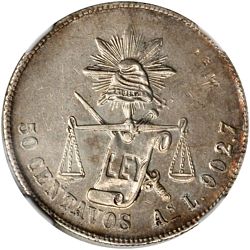
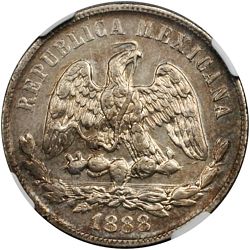
KM-407 Alamos 50c 1888-AsL probably unique (Stack’s Bowers Baltimore auction, 28 March 2011, lot 9142)
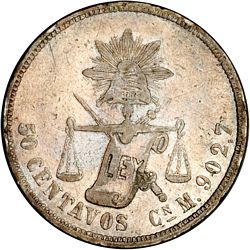

KM-407.2 Culiacán 50c 1888-CnM probably unique (Stack’s Bowers Baltimore auction, 28 March 2011, lot 9161)
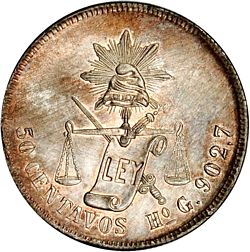

KM-407.5 Hermosillo 50c 1888-HoG extremely rare (Stack’s Bowers Baltimore auction, 28 March 2011, lot 9193)
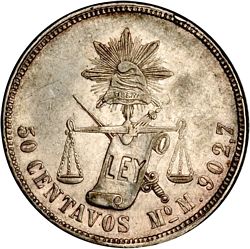
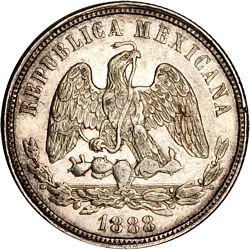
KM-407.6 Mexico City 50c 1888-MoM probably unique (Stack’s Bowers Baltimore auction, 28 March 2011, lot 9215)
Half-crown sized coins have not been particularly popular throughout history. During the Spanish colonial experience mintage figures indicate that the four-reales denomination was struck in far fewer quantities than the eight-reales. Even in contemporary times, when was the last time you received a half dollar in change? The following table, derived from the 1888 annual report of Britain’s Deputy Master of the MintAnnual Report of the Deputy Master of the Mint, 1888, p. 41, demonstrates the rapid decline in Mexico’s striking of the 50 centavos coin.
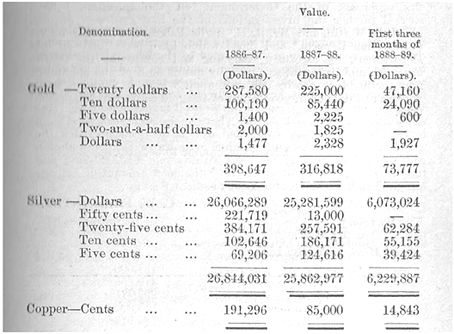
The British mint report demonstrates the precinpitous drop in the production of half pesos during the period and, as with Pradeau, tabulates production figures by fiscal year, e.g. from July of one calendar year thru June of the following calendar year. Thus, according to the British report, some $13,000 (26,000 pieces) of 50-centavos coins were generated by all active mints in Mexico sometime from 1 July 1887 thru 30 June 1888. Specific mints are not mentioned in their report. So, theoretically, some of those coins could have been struck in the first half of calendar year 1888, thus, bearing said date. The last column, indicating no coins struck, covers the three month period of 1 July thru 30 September 1888, the first quarter of fiscal year 1888-1889.
The Annual Report of the Director of the US Mint 1889 US Treasury, Annual Report of the Director of the US Mint, Washington, DC, 1889, however, provides additional detail, to include figures for each of the active mints and, importantly, on a calendar year basis (1 January - 31 December 1888).
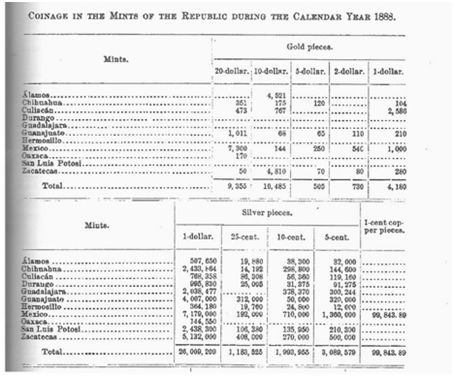
Importantly, the US Mint report depicts no/no column for the 50-centavos piece (half peso). How can that be? What is the explanation? Without access to the respective Mexican mints’ annual reports, per se, we can only speculate. Could Mexico’s 1888 fifty-centavos coins be the US equivalent of the 1913 liberty head nickel; e.g. an unauthorized “midnight” strike by a wayward mint employee? Not likely, since the few coins which have surfaced or been reported are from some five different mints, all widely scattered, geographically. Some suggest that Mexico City may well have prepared and distributed a full set of dies to the branch mints for all denominations then in use in 1888, whether the branch mints planned on using all of them or not. Thus, dies for the half-peso may well have been available, even though not used at most facilities. One explanation is that the mints in question may have had residual silver blanks for the fifty-centavos coin from prior year production runs. Rather than melt them down, they may have struck the few remaining blanks, simply logging them at their appropriate gross value, but under another denomination. All five mints in question had struck the fifty-centavos piece in the early- or mid- 1880s and, thus, could have had extraneous blanks in their possession. It is worthwhile noting that all five mints of interest produced 25-centavos pieces in the year 1888. Another explanation is that selected mints made test strikes of the fifty-centavos for 1888 in anticipation of doing production runs that year which never materialized.
.
.
.
